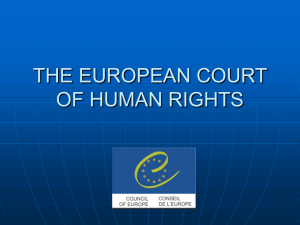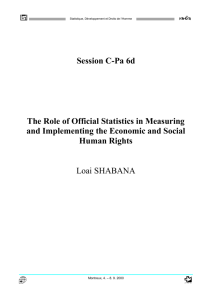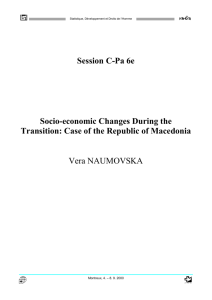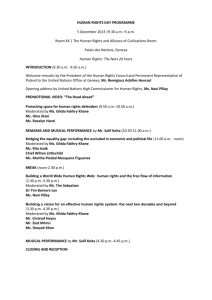Observing the effectiveness of human development and the aspect
advertisement
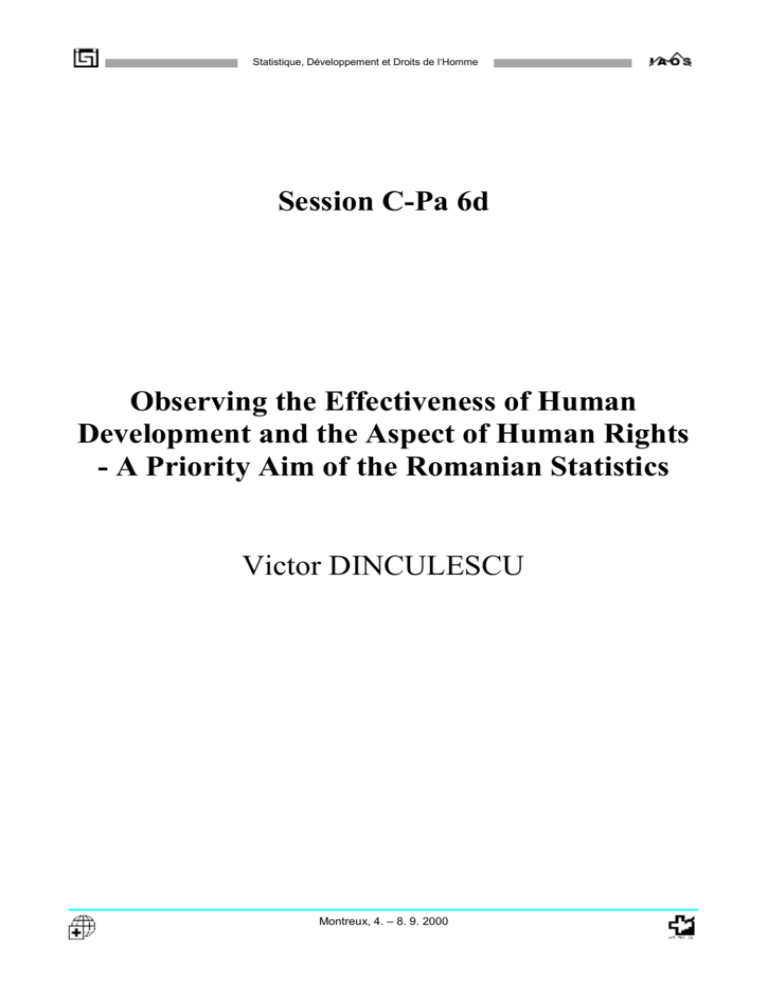
Statistique, Développement et Droits de l‘Homme Session C-Pa 6d Observing the Effectiveness of Human Development and the Aspect of Human Rights - A Priority Aim of the Romanian Statistics Victor DINCULESCU Montreux, 4. – 8. 9. 2000 Statistique, Développement et Droits de l‘Homme Observing the Effectiveness of Human Development and the Aspect of Human Rights - A Priority Aim of the Romanian Statistics Victor DINCULESCU President, National Commission for Statistics Libertatu Avenue 16, Sector 5 Bucharest, Romania T. + 40 1 312 48 75 F. + 40 1 312 48 73 Victord@cns.ro ABSTRACT Observing the Effectiveness of Human Development and the Aspect of Human Rights - A Priority Aim of the Romanian Statistics The Romanian official statistics count, among their basic working principles, the priority given to ensuring the public information system by duly observing the users free access to information. At the same time, Romanian statistics is dedicated to promoting the development and use of official statistics as an instrument for observing and measuring human rights implementation and human development effectiveness. Starting from the various aspects of the human rights issue regarding the right to development, the economic/social/cultural/political/civil rights, the statistics provides the most reliable instruments and methods in measuring and monitoring the implementation of human rights and in studying human development progress, respectively. The measurement of human development level and progress is done through a set of advanced statistical records and indicators covering the many fields of sustainable development, achieved as a result of the experience gained over the past five years of statistical work. The measurement and monitoring of basic human rights implementation and sustainable human development materialized into the indicators obtained as a result of the statistical surveys carried out by the official statistics. The domains covered through the information available mainly concern the human resources size, the educational level, the population health condition, manpower planning, the people’s living and welfare conditions, human security and social protection, the development impact upon the environment, the weakening of the overall social system, the trend in anti-social acts, the participation in public activities and the decision-taking process, the deprivations and setbacks in human development, and obviously the population/human development relation. Information about the civil society’s role and importance or about the carrying into effect of governmental policy with respect to human rights observance and human development are also made available. Last but not least, aspects relative to the way in which general statistics respects human rights by furthering the essential statistical principles and in particular those regarding the autonomy, the transparency, the rule of confidentiality and data relevance are shown as well. 2 Montreux, 4. – 8. 9. 2000 Statistique, Développement et Droits de l‘Homme RESUME L'observation de l'efficacité du développement humain et la question des droits de la personne: un objectif prioritaire des statistiques roumaines Les statistiques officielles roumaines comptent, parmi leurs principes fondamentaux, la priorité accordée à l'information du public moyennant la garantie de la liberté d'accès des utilisateurs aux données. Par ailleurs, les responsables des statistiques roumaines visent également à promouvoir le développement des statistiques officielles et leur emploi en tant qu'outil d'observation et de mesure du respect des droits de la personne et de l'efficacité du développement humain. Se fondant sur les divers aspects de la question des droits de la personne, qu'il s'agisse de celui au développement ou des droits économiques, sociaux, culturels et civils, les statistiques constituent des instruments et des méthodes particulièrement fiables de mesure et de surveillance du respect des droits de la personne et d'étude du progrès du développement humain. La mesure du niveau de développement humain et des progrès en la matière a lieu au moyen d'un ensemble de dossiers et d'indicateurs statistiques hautement élaborés et qui couvrent les nombreux aspects du développement soutenable: résultat de l'expérience accumulée au cours des cinq dernières années consacrées au travail statistique. La mesure et la surveillance du respect des droits de la personne ainsi que d'un développement humain soutenable se sont concrétisées sous forme des indicateurs obtenus en tant que résultats des enquêtes statistiques menées par les services officiels spécialisés. Les domaines visés par les informations disponibles concernent essentiellement l'entité des ressources humaines, le niveau d'instruction, les conditions sanitaires de la population, le planning de l'emploi de la main-d'oeuvre, les conditions de vie et le bien-être des gens, la sécurité humaine et la protection sociale, l'impact du développement sur l'environnement, l'affaiblissement du système social global, la diffusion croissante des actes antisociaux, la participation aux activités publiques et les processus de prise des décisions, les déficits et les échecs en matière de développement humain ainsi que, bien entendu, les rapports entre population et développement humain, les informations sur le rôle et l'importance de la société civile, et la mise en oeuvre des politiques gouvernementales en matière de respect des droits de la personne et de développement humain. Enfin, l'article traite également des aspects relatifs au rôle joué par les statistiques dans le domaine du respect des droits de la personne au niveau des principes essentiels sur lesquelles elles se fondent, en particulier ceux de l'autonomie, de la transparence, de la confidentialité et de l'importance des données concernées. 1. Statistics and Human Development Measurement The universal observance of human rights is a priority concern for all nations. Over the past decades, the preoccupation’s of the international community in this respect increasingly focused on the understanding and presentation of the interrelationship between population, human rights and the achievement of the development goals. As a matter of fact, it is unanimously acknowledged that the right to development is an universal and indivisible right, integrate part of people’s essential rights and that human beings are the core of concerns for a sustainable development. The relevant concepts included in the Universal Declaration of Human Rights stipulate the recognition of people as equals before the law, the right to found a family, the right to work and to receive an equal pay to equal work, the right to education, to social security, to health and to an adequate standard of living. This is the reason why the sustainable development concept is considered to be a means of providing an equitable welfare level distributed among present and future generations. The development targets take into account the interactions between people, resources and environment 3 Montreux, 4. – 8. 9. 2000 Statistique, Développement et Droits de l‘Homme to ensure a sustainable Human Development. It is consequently obvious that the statistics plays a major role not only in measuring and diagnosing the human development level reached by a certain country but also in the monitoring and assessment of the implementation of the socio-economic rights contributing to an appropriate human development. The official statistics has among its priority principles the assurance of an impartial society information system by observing the free access of all citizens and users to public information. At the same time, public statistics promotes, within such principles, the development and use of the statistics and indicators produced as an observation and measurement tool in the implementation of human rights in agreement with effective national legislation, as well as the human development efficiency. The statistical information made available helps to characterise the human development process and its basic components like productivity, equity, sustainability, empowerment. One main statistical purpose in achieving such key objectives is to further the dialogue and multidisciplinary co-operation among suppliers, producers and users of official statistics, first of all with the decision makers and the civil society representatives in order to work out suitable policies and to monitor and evaluate the respect for human rights which are essential to asure the sustainable development. If one takes into account the principles of indivisibility and interdependence of the various forms of human rights regarding the right to development, socio-economic, cultural, political and civil rights, then the statistics is meant to choose the most reliable mechanisms and methods in monitoring and evaluating the implementation and observance of human rights within the human development process. This priority statistical target is to be found in the ways in which it provides the measurement of human development level and the monitoring of the implementation of the policies aiming to achieve a sustainable human development. To do this, a sophisticated system of statistics and indicators covering the many fields of human development and characterising the development in time of the process as such was specifically set up. This system of indicators was made up with due attention paid to the fact that the economic support of human development is the sustainable development as an essential means to ensure wellbeing equitably shared by all society members. All the same, one cannot omit the issues specific to the social life, human relations and malfunctions occurring in the assurance of social cohesion, including the non-discrimination in public life and decision-making participation. The practice of the Romanian official statistics proves the necessity to develop a system of indicators characteristic of human development and associated rights observance, requiring constant improvement in order to fill some gaps or to add information from new fields related to such development. The traditional domains covered through the available information concern the human resources size, the educational level, the population’s health condition, the work resources employment, the living conditions, the human security, the social security and protection, the relationship between human development and economic development, the relationship between human development and environment, but equally important are the aspects related to the participation in public life and decision-making, the role and involvement of NGO’s, the social system weakening phenomena and the increase of deviant behaviour, as well as the revelation of the privations and inconsistencies appearing in human development. 2. Priority Statistical Tasks in Observing and Evaluating the Human Development Level The statistical system characterising the human development level and evolution comprises a multitude of indicators related to the target fields of development expressed in a variety of computation forms. Basically, the statistical indicators are expressed not only in absolute values but also in relative indicators (expressing the structure, the dynamics, the intensity, the ratio), in measures of Central tendency (average, median, module), as a variation indicator (dispersion, 4 Montreux, 4. – 8. 9. 2000 Statistique, Développement et Droits de l‘Homme skewness) or in correlation indicators and indices. As a rule, they are presented in a quantitative form, using also graphic techniques. The design of the human development statistical indicators should also take into account the approach domains as they determine the information presentation manner, which may be quite large. For example the principles of equal opportunities are presented compared to those connected with the economic development or the access to education and health care, the right to adequate and to a decent living standard, the poverty alleviation or those relative to the production capacity and the right to political and civil freedoms. Thus hereinafter I shall try to make a synthetic presentation of the range of information used to observe and assess the human development dimensions, the measurement and monitoring of the implementation process and the associated effects relative to the human rights policies and measures applied, respectively. 2.1 Human Resources Assessment The trends in the human resources size and the intervened structural changes, as well as the human cohabitation forms can be obtained through indicators referring to the dynamics and structure of the population and families and also through the trends in the demographic phenomena. The tendencies in population’s numerical evolution and structures allow us to underline the changes occurred in the total population or in certain population groups (women - men, young ones - adults old people, population groups according to their ethnic or confessional belonging), in the dynamics of populations (in time and in space) and in the age and marital status structure. Relevant to the field is the demographic ageing process and its related socio-economic consequences. The demographic situation is presented through the main indicators relative to fertilityand mortality, to internal and international migration or the population’s evolution as consequence of the size of the total/natural/migratory increase. The demographic rates and ratios are represented by the fertility/abortion rates and, the proportions of live born by rank, the underweight ones or those born the wedlock. The way of setting up a family and its stability, as well as the living arrangements forms (within or outside the households) is shown by the nuptiality and divorciality and by the structure of households and families, where the consensual arrangements, the single-parental families and the single persons living alone, acquired a peculiar importance. Such information refer to a number of human rights, among which the right to life and personal security, the right to conclude a marriage and to found a family, the right to a health, reproductive and the observance of specific children’s, women’s and family rights. 2.2 Right to Education As concerns the right to education, a wide range of statistical indicators refer to equal opportunities in knowledge acquirement and educational level improvement and to a complete development of the human resources by ensuring the human capital formation directed to the full development of human dignity and potential. Based on evaluating the human capital stock and quality and on the population structure according to educational level, also important are the indicators following the educational process development, including the size and structure of the school population, school enrolment ratio and educational quality respectively. Special stress should be paid on following the higher education access (high school, university), the school graduation and abandon rates, the ratio teaching staff/trained school population or the measures meant to reduce the illiteracy rate, particularly among the young and teenage population. Particular attention is given to the education being a key element to a sustainable development, allowing the human resources integration in society life, which also represents an essential factor towards an improvement in the welfare through manpower employment. 5 Montreux, 4. – 8. 9. 2000 Statistique, Développement et Droits de l‘Homme 2.3 Health Regardless of the economic development level of a society, special attention should be paid to the three essential sides of human development, namely the provision of a long and healthy life through acquisition of the required information and knowledge and a guaranteed access to the necessary resources and quality health services, to have a decent living standard and to enjoy the best possible physical and mental health standard. Therefore, in health one should take all appropriate measures to ensure, based on the equality among sexes, a universal unrestricted access to health care services including those related to family planning and sexual health. The statistical indicators characterising the development in the population’s health condition and the access to quality health services comprise a variety of information relative to life expectancy at birth and various ages, the morbidity level and evolution the prevalence and incidence of illnesses), the evolution of general and differential mortality, mainly the infantile/juvenile/maternal one. It is also important to show the coverage of the national health system, the provision of adequate health services and medical - care quality including capacity health units of their activity (consultations and treatments), the assurance of a suitable ratio between medical staff (doctors and nurses) and the attended population. Useful information is needed with respect to reproductive health and sexual problems among which the family planning, the abortion rate, the contraception prevalence rates and the extent of the sexually transmitted diseases, HIV and AIDS included. The reproductive rights including the basic right of individuals and couples decide to freely and responsibly on the desired number and spacing of their children, as well as on the right to a free and healthy sex life should also be monitored. 2.4 Right to Work One important field of human development is that concerning the labour resources and the employment of the available human capital. The participation rates in the socio-economic activities and the available opportunities on the labour market allow the turning into account by the human resources of the potential production capacities with a view to ensure the human needs to reach a satisfactory welfare standard (decent food/housing/old age/living conditions). Thus, besides characterising the evolution of the labour resources volume and structure, the specific statistical indicators follow the use of the existing labour force, the employment rate, the labour cost, the jobs availability on the labour market and the equal competition. In addition to the activity and employment rates, differentiated by age/gender/educational pattern, also important are the statistics on under - and unemployment issues. In a dynamic view, equally important are the evolution of the labour renewal rate or the economic dependency one within the community/family, the size and proportions of the expenses required for the employment/reconversion schemes and the creation of new jobs. Lately and in the long run there appeared aspects that should be followed, especially as regards the evolution and causes of under employment, the ratio between paid and unpaid labour or the evolution of the “non-standard” workplaces (temporary, seasonal, part time or on own account on a discontinued basis), which do not provide an adequate employment of the existing labour force. 2.5 Conditions of Life The human development is also organically dependent upon the way in which people can provide a decent living standard and a suitable existence for themselves. The representation and evaluation of the people’s living conditions or those regarding the inequalities and poverty are done through statistical indicators assessing the value, the size and the structure of the household incomes 6 Montreux, 4. – 8. 9. 2000 Statistique, Développement et Droits de l‘Homme or of the employed/unoccupied population. According to the professional status, the size and structure of the population’s actual incomes may also serve to characterise the disparities existing in the incomes structure or in their polarisation process affecting the social cohesion. Equally important is to strengthen the quality of information in order to ensure time comparability of the population’s incomes and expenditures structure, expressed in real values (real income/wages/pension). The disparities in the households consumption level, also indicating the inequality in income distribution are highly relevant for human poverty dimensions. The poverty size and trends and the amount of people living below the absolute or relative poverty threshold enable a correct accurate settlement for the strategy of the poverty reduction policy mainly oriented toward the marginal and vulnerable groups. Other important aspects regarding this vast and complex human development field refer to the status and the achievement of comfortable living conditions. Thus, specific indicators can characterise the human consumption expressed either through average annual consumption’s of food (quantitatively or in calories and nutrients), the consumption level, the provision of products and services necessary for a decent living (including housing services) socio-cultural ones and also specific elements evaluating the population’s housing conditions type of dwellings, their size/ endowment/occupancy a.s.o.). In a so complex field as the living arrangements, an extended attention should be given to monitoring and assessing the implementation of the internationally-adopted socio-economic rights like the European Social Chart, recognised by all the Council of Europe member countries. 2.6 Social Issues The whole human development issues should not neglect the promoted social policies whose role is crucial in solving specific social aspects related to assure social security benefits for all. Over the past transition period in Romania, special attention has given to minimising the social costs of the economic reform and the transition to a market economy. In this respect, just like in other transition countries, the decision makers focused their attention on the extension of poverty process in order to decrease the disparities and a higher social polarisation (particularly as concerns the revenues or the private property) or the increasing social deviations (antisocial behaviour, social inequities, a.s.o.). The statistical indicators expressing the development in public expenditure for social protection purposes (education, health, culture, environment, housing) were included among those indicating the evaluation of the social security system. Attention was also given to assessing the effects of the applied legislative and political measures in the social protection field. In particular, detailed information were provided with respect to the pension and social security system, the unemployed protection and reinsertion plan and the social assistance system based on social solidarity, respectively. Particularly relevant proved to be the statistics stressing the dynamics and proportion of the expenditures for social protection and social services versus the GDP, the overall population consumption or within the national public budget. Naturally, the importance of social expenses within the population’s incomes, as well as the insurance of a minimum equitable consumption and of a decent living standard was also emphasised. The characterising based on statistical data of the poverty extent, which undermines the right to human development and well-being, provides the conditions necessary to adopt viable strategies and poverty-reduction policies, having in mind that the poverty process and other associated variables such as the unemployment, the malnutrition, the illiteracy, the health condition, the social inequities obviously affect the human development evolution. 2.7 Public Participation 7 Montreux, 4. – 8. 9. 2000 Statistique, Développement et Droits de l‘Homme The assessment of the human development level and evolution together with the measurement of human rights observance also depend on other domains for which different information was provided through the system of statistical indicators. I shall attempt hereinafter to present some of them, the most relevant to our approach. One such field is the participation in public life and decision-making, indicative of the way in which non-discrimination in public life, irrespective of nationality, language, faith, sex, opinion, political affiliation, social origin and equality of all citizens before the law and public authority are observed. The unrestricted participation in public life and decision-making (legislative, executive, socioeconomic) must be assured by opposing any kind of discrimination, differentiation, exclusions or restrictions. As to the social equity and stability it is important to define the role and involvement of the NGO’s and of the partnership and co-operation with the public administration and public institutions. One should follow the mentalities and behaviour patterns of people in community, the dimensions of the deviant behaviour included. Special attention should be attached to the weakening of the social system due to the spreading of the deviant behaviour and antisocial deeds. It is required based on relevant information the size of the conflicting / non-conflicting character of the social relations hips (political, economic, ethnic), as any unbalance influences upon social stability. Another field of interest is the perception of the government legitimacy, the way in which the authorities promote policies meant to strengthen the social dialogue and social cohesion. Also necessary are the information about the implementation of actions aiming towards the insurance of the social equity and stability. 2.8 Inequalities The general statistical concerns referring to the evaluation of the human development evolution should necessarily include indicators describing the existent privation level in human development, the inequities and the inequalities at the family and community level. Among the large range of available indicators - although one appreciates that for some of them the information is still not sufficient - we shall remind those dealing with the equal rights between genders, as well as with the women’s empowerment. To which the minority rights may be added. One should also remember the privations in living conditions and the role of the state/decision makers in workingout the tools capable of providing a suitable well-being. One cannot possibly leave aside the malfunctions present at the family level, expressed through aspects related to the family nucleus, broken-up families, inter-family violence, vagrant children or men’s responsibility in the family and the respect of women’s and children’s rights. Finally, in our country there persist disparities at the human development level and between the living conditions in the urban and rural areas, deprivations which should be surpassed through appropriate programmes and policies. 3. Statistics and Respect of Human Rights During the past decades, the official statistics acquired new dimensions, both on an international and national level. The statistics is increasingly involved in the decision-making process, not only as an information provider but also by implicitly participating in the working-out, of the human development strategies and programmes but also in the monitoring and evaluation of the implementation results in various fields of the economic, social and political life. Starting from the principle that the statistical information represents an essential base in successfully implementing the development strategy in the socio-economic and environment 8 Montreux, 4. – 8. 9. 2000 Statistique, Développement et Droits de l‘Homme protection fields, the official statistics is asked to strive toward becoming an indispensable tool in the information system of the democratic society by providing to every user available data in a perfectly impartial way, in order to guarantee the free access to public information for all citizens. Equally important is a reliable statistical information system for all the political decision makers, on a national or local level, in the governmental/legislative/political decision-making process in order to observe the principle “good policies need reliable statistics”. To the statisticians it is quite obvious that the confidence of the public and of all statistical information users can only be acquired by respecting the values and principles the official statistics promoted to guarantee the right to information. The international statistical community included to this purpose in the fundamental principles of the official statistics activity, among others, the following : a. the principle of autonomy to ensure and disseminate the statistical data and information in an impartial and independent way with no interventions of any kind and from any position of interest of the government, the politicians, the trade and employers unions, minority groups and other organisations or persons. Actually, I trust that in our statistical work we should be guided by a steady concern for impartiality according to which “the statistics should be political relevant but not politically directed“. b. the principle of transparency in conformity with which the statistics is bound to observe and assure the rights of the providers and users of statistical information and also of other categories of individual or judicial persons interested in having access to the statistical legislation, purposes, methods and survey results, respectively. Under such circumstances, it appears that the statistics should guarantee through the performed activity not only the access to the statistical information produced but also the taking of suitable measures, so that the survey programmes should be able to provide information for the measurement of human rights observance, as well as for the diagnosis of the human development size on national level. The transparency may be ensured through any data editing process of the available information, provided in terms that the official statistics has the necessary resources and capacity. c. the principle of confidentiality in accordance to which covering the whole statistical work from registration to dissemination and publication respectively, the protection of the data and information referring to individual statistical subjects (individual and judicial persons) is fully ensured. This guarantees the observance by official statistics of the fundamental rights and freedoms, the right to a private life and to privacy in particular, through all the stages of statistical information processing. d. the principle of relevance and that of observing the professional ethics rules through the assurance of a full objectiveness, the impartiality and the respect for the professional integrity. In this respect, the statistics is preoccupied with the accessibility, scientific consistency, quality of data and completeness of the information made available to the users. I would also like to mention that the Romanian statistics constantly follows the good practices in official statistics as promoted by the international community. The associated measures adopted until now are concerned with the production of reliable, consistent and relevant statistics, the provision of an easy access for the users, the correctness of the estimations and the suitable documentation of the employed definitions and methods based on common methodological concepts, classifications and standards in line with the international ones. It is worth mentioning that due to the fact that the statistics must measure and indicate the real human development level and the respect of human rights, one of the current preoccupation and a future challenge too being the necessity that the official statistics should not only complexly describe the socio-economic phenomena and processes but also contribute to a larger extent to the 9 Montreux, 4. – 8. 9. 2000 Statistique, Développement et Droits de l‘Homme understanding of the concerned phenomena. Without a proper understanding of such factors it is very difficult to define policies and programmes meant to correctly accomplish the desired objectives. This is why the official statistics is required to further the carrying-out of complex socioeconomic analyses. Thus it may contribute to the monitoring and evaluation of the socio-economic rights implementation in order to have a sustainable human development. In the end, I should like to draw to the attention of the international community of official statisticians on the necessity to promote initiatives aiming at a larger co-operation in designing a system of international statistics and indicators conceptually and methodologically comparable, targeting the monitoring and assessment of the way the UN-established human rights are observed. 10 Montreux, 4. – 8. 9. 2000
